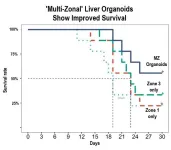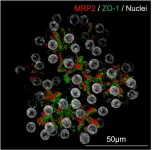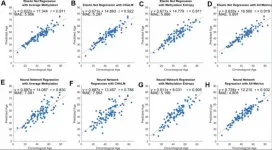(Press-News.org) As we age, blood stem cells, the essential source of new blood cells in the body, can accumulate genetic mutations. These mutations can give the cells a growth advantage, laying the foundation for developing serious health conditions. Now, scientists at The Jackson Laboratory (JAX) have not only discovered the mechanism that fuels their unchecked growth but have also found a way to stop it.
Led by Jennifer Trowbridge, professor and The Dattels Family Chair at JAX, the study reported today in the April 16 issue of Nature Communications reveals that a common aging-associated mutation in the gene Dnmt3a boosts the power-generating function of mitochondria in blood stem cells. This mutation allows the cells to make copies of themselves more readily than normal and creates fertile ground for the development of clonal hematopoiesis, a condition that dramatically increases the risk of heart disease, blood cancers, and other illnesses.
Although clonal hematopoiesis develops silently with age— more than half of all 80-year-olds are estimated to be affected by the condition — the mutated blood stem cells can produce inflammatory molecules that disrupt blood production and weaken the immune system.
“This work gives us a new window into how and why blood stem cells change with age and how that sets up an increased risk of diseases like cancer, diabetes, and heart disease,” said Trowbridge. “It also points toward a new opportunity to intervene and potentially prevent age-associated conditions not only in the blood but everywhere the blood touches.”
A common genetic mutation
Building on her previous work and that of others, Trowbridge’s team knew that Dnmt3a is frequently mutated in blood stem cells with aging as well as in blood cancers. To investigate why cells with this mutation gain a competitive advantage over normal cells, the team developed a mouse model carrying the Dnmt3a mutation.
In this new study, the team discovered that in middle-aged mice, the mutated stem cells had double the energy-producing capacity of normal cells. The mutated stem cells also contained turbocharged mitochondria, which gave the cells a strong competitive growth advantage.
“This was really unexpected,” Trowbridge said. “This gene was not previously known to impact metabolism or mitochondria.”
Targeting mitochondria
The researchers realized that because the stem cells with Dnmt3a mutations relied so heavily on their overactive mitochondria to support their growth, the mitochondria might be an Achilles heel for the mutated cells. In isolated stem cells and mice with Dnmt3a mutations, the team tested the effect of MitoQ and d-TPP – molecules which disrupt the normal function of mitochondria and prevent them from producing energy. In a separate paper co-published today in Nature, Trowbridge and co-authors report that metformin—a first-line treatment for type 2 diabetes—also diminishes the competitive advantage of stem cells carrying the Dnmt3a mutation.
In mice with Dnmt3a mutations and clonal hematopoiesis, the mitochondria-targeting drugs had drastic effects. Within a few days of treatment, about half of all mutant cells died and among remaining mutant cells, their energy production dropped to normal levels. Normal cells – which don’t rely as heavily on the same metabolic pathway – were not impacted.
“Seeing this selective vulnerability where mutated cells were weakened, but normal stem cells are fine, was really exciting,” said Trowbridge.
Hope for human disease
The mitochondrial drugs worked not only in mice with clonal hematopoiesis, but in human blood stem cells engineered to have the DNMT3A gene mutation. The results suggest that the strategy could work in treating humans with the condition to prevent blood cancers and other age-related illnesses.
However, more work is needed to understand whether these drugs would be effective at targeting other mutations observed in clonal hematopoiesis and the effect of the drugs on cells.
END
Supercharged mitochondria spark aging-related blood disorders
JAX Scientists not only uncover how an energy boost from mitochondria fuels blood disorders, but also how to shut it down
2025-04-16
ELSE PRESS RELEASES FROM THIS DATE:
New human “multi-zonal” liver organoids improve injury survival in rodents
2025-04-16
One reason why our livers excel at clearing waste from our blood system is that the organ functions according to three key “zones” that perform specific major tasks. So, if scientists hope to create self-growing patches of liver organoid tissue that could help repair damaged organs, it’s important that the lab-grown tissue faithfully reproduce such zones.
In a groundbreaking paper published April 16, 2025, in the prestigious journal Nature, a team of organoid medicine experts at Cincinnati Children’s reports achieving just such a milestone – made from human stem cells. When these humanized organoids were transplanted into rodents whose own liver-bile duct system ...
Scientists achieve record-breaking growth in miniature, functional liver models
2025-04-16
Replicating the liver’s complexity
While organoids aim to mimic human organs, the liver’s repertoire of complex functions – and thus the energy it needs to operate – have made it challenging for researchers to grow organoids that proliferate and fully function, says Sato. When prioritizing growth and survival in laboratory settings, hepatocytes, the liver’s main cells, eventually transformed into cells resembling cholangiocytes, which line the bile duct. Hepatocyte functions only lasted 1-2 weeks at most.
The study team, led by Ryo Igarashi and Mayumi Oda at the Keio University School of Medicine, ...
Novel machine learning model can predict material failure before it happens
2025-04-16
A team of Lehigh University researchers has successfully predicted abnormal grain growth in simulated polycrystalline materials for the first time—a development that could lead to the creation of stronger, more reliable materials for high-stress environments, such as combustion engines. A paper describing their novel machine learning method was recently published in Nature Computational Materials.
“Using simulations, we were not only able to predict abnormal grain growth, but we were able to predict it far in advance of ...
Hereditary Alzheimer’s: Blood marker for defective neuronal connections rises early
2025-04-16
Individuals with a genetic predisposition to Alzheimer’s disease show altered blood levels indicating damaged neuronal contacts as early as 11 years before the expected onset of dementia symptoms. This is evident in the levels of the protein “beta-synuclein”. An international team, including researchers from DZNE, Ulm University Hospital and University Medicine Halle report these findings in the journal “Alzheimer’s & Dementia”. The biomarker studied here could potentially help to detect neurodegeneration at an early stage and thus ...
Nature-based activity is effective therapy for anxiety and depression, study shows
2025-04-16
Researchers evaluating a nature-based programme of activities for patients with mild to moderate mental health conditions have shown that improvements in mood and anxiety levels can be seen in as little as 12 weeks.
As part of the UK government’s commitment to transform mental health services, seven ‘test and learn’ green social prescribing sites were identified across England, which included a programme in Humber and North Yorkshire - the first of the seven sites to publish results from the national programme.
Green social prescribing is a practice whereby a healthcare professional refers a patient to community-based nature activities ...
New genomics tool accelerates biomedical breakthroughs
2025-04-16
A University of Virginia School of Medicine scientist and collaborators have developed a much-needed new tool to increase the efficiency of genomic research and accelerate the development of new ways to improve human health.
UVA researcher Nathan Sheffield, PhD, has spent four years developing a new data standard to ensure that scientists are comparing apples to apples when doing genomic analysis. This type of analysis helps researchers understand the operating instructions for our cells and see how those instructions are carried out. The resulting insights help us understand the workings of both healthy cells and unhealthy ones, pointing us to new ways to treat and prevent disease.
Genomics ...
DNA methylation entropy: A new way to track and predict aging
2025-04-16
“We find that epigenetic clocks based on the entropy of methylation states predict chronological age with similar accuracy as common approaches that are based on methylation levels of individual cytosines.”
BUFFALO, NY — April 16, 2025 — A new research paper was published in Aging (Aging-US) Volume 17, Issue 3, on March 12, 2025, titled “DNA methylation entropy is a biomarker for aging.”
Researchers Jonathan Chan, Liudmilla Rubbi, and Matteo Pellegrini from the University of California, Los Angeles, led a study that discovered a new way to measure changes in DNA that can help predict a person’s ...
Mount Sinai Fuster Heart Hospital recognized by Press Ganey for patient experience excellence
2025-04-16
The Mount Sinai Fuster Heart Hospital’s cardiology faculty practice has received the 2024 Human Experience Pinnacle of Excellence Award® from Press Ganey, one of the nation’s leading patient experience organizations.
The faculty practice is located at The Mount Sinai Hospital and has several physicians with top expertise in cardiovascular care. It is one of 10 heart centers across the country, and the only one in New York, to receive this prestigious award placing it on the leading ...
Nurturing now, thriving later: The lasting power of affectionate mothering
2025-04-16
Affectionate mothering in childhood may have a lasting impact on important personality traits, potentially influencing life outcomes such as educational achievement, economic success, and health and well-being, according to research published by the American Psychological Association. The findings suggest that positive maternal parenting could foster important traits such as openness, conscientiousness and agreeableness.
“Personality traits are strong predictors of important life outcomes, from academic and career success to health and well-being,” ...
A step toward harnessing clean energy from falling rainwater
2025-04-16
When two materials come into contact, charged entities on their surfaces get a little nudge. This is how rubbing a balloon on the skin creates static electricity. Likewise, water flowing over some surfaces can gain or lose charge. Now, researchers reporting in ACS Central Science have harnessed the phenomenon to generate electricity from rain-like droplets moving through a tube. They demonstrate a new kind of flow that makes enough power to light 12 LEDs.
“Water that falls through a vertical tube generates a substantial amount of electricity by using a specific pattern of water flow: plug flow,” says Siowling Soh, the study’s corresponding ...
LAST 30 PRESS RELEASES:
New study overturns long-held model of how plants coordinate immune responses.
New AI model predicts disease risk while you sleep
Scientists discover molecular ‘reshuffle’ and crack an 80-year-old conundrum
How stressors during pregnancy impact the developing fetal brain
Electrons lag behind the nucleus
From fungi to brain cells: one scientist's winding path reveals how epigenomics shapes neural destiny
Schizophrenia and osteoporosis share 195 genetic loci, highlighting unexpected biological bridges between brain and bone
Schizophrenia-linked genetic variant renders key brain receptor completely unresponsive to both natural and therapeutic compounds
Innovative review reveals overlooked complexity in cellular energy sensor's dual roles in Alzheimer's disease
Autism research reframed: Why heterogeneity is the data, not the noise
Brazil's genetic treasure trove: supercentenarians reveal secrets of extreme human longevity
The (metabolic) cost of life
CFRI special issue call for papers: New Frontiers in Sustainable Finance
HKU Engineering scholar demonstrates the smallest all-printed infrared photodetectors to date
Precision empowerment for brain "eavesdropping": CAS team develops triple-electrode integrated functional electrode for simultaneous monitoring of neural signals and chemical transmitters during sleep
Single-capillary endothelial dysfunction resolved by optoacoustic mesoscopy
HKU three research projects named among ‘Top 10 Innovation & Technology News in Hong Kong 2025’ showcasing excellence in research and technology transfer
NLRSeek: A reannotation-based pipeline for mining missing NLR genes in sequenced genomes
A strand and whole genome duplication–aware collinear gene identification tool
Light storage in light cages: A revolutionary approach to on-chip quantum memories
Point spread function decoupling in computational fluorescence microscopy
BacPhase: Long-insert paired-end sequencing for bin marker construction and genome phasing
GmWOX1 regulates the mediolateral polarity of compound leaves in soybean
ChargeFabrica: An open-source simulation tool that aims to accelerate search for high performance perovskite solar cells
High levels of ADAR overexpression induce abundant and stochastic off-target RNA editing in rice protoplasts
On-demand upgraded recycling of polyethylene and construction of sustainable multifunctional materials based on the "LEGO" strategy
New "Stomata in-sight" system allows scientists to watch plants breathe in real-time
Anorexia nervosa may result in long-term skeletal muscle impairment
Narrative-based performance reviews deemed fairest by employees
New insights reveal how advanced oxidation can tackle emerging water pollutants
[Press-News.org] Supercharged mitochondria spark aging-related blood disordersJAX Scientists not only uncover how an energy boost from mitochondria fuels blood disorders, but also how to shut it down






